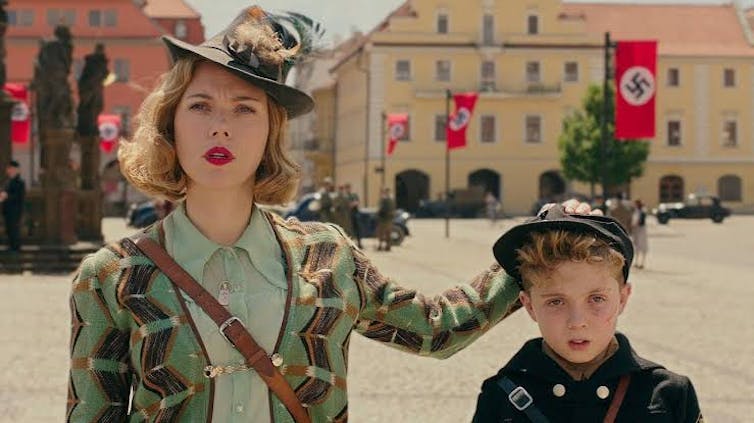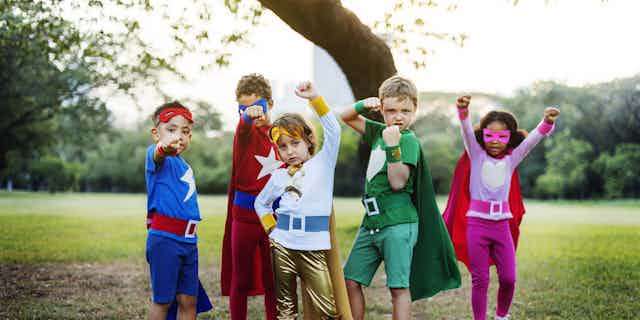The protagonist of the decorum-defying but wildly entertaining new film, Jojo Rabbit, sees the world in black and white. The film is set in Nazi Germany and ten-year-old Jojo is a fiercely committed member of the Hitler Youth. For him, Aryans are good and Jews are bad.
His mother, Rosie, who is working with the resistance and hiding a Jewish teenager in the attic, does nothing to encourage her son’s abhorrent worldview, but nor can she risk openly contradicting him. She lavishes affection on Jojo, urges him to have fun and climb trees and tells him that love “is the strongest thing in the world”.
The circumstances in which Rosie and Jojo find themselves are, mercifully, unusual. Whatever challenges most of us face in trying to support the moral development of our children, we do not have to contend with the effects of Nazi indoctrination, and we do not risk our lives in trying to undo them. Still, there is an analogue of Rosie’s dilemma that is faced by more or less every parent: at what age, and how directly, should we steer our children away from the simplistic idea that people are either good or bad, virtuous or vicious, on the side of the angels or in league with the devil?
It takes a particularly perverse form of upbringing to connect the categories of good and bad with categories of race or ethnicity. But the basic division of people into heroes and villains is hard to get away from. It is embedded in fairytales and storybooks, myths and legends, religious narratives and moral allegories, crime novels and superhero films. Children everywhere learn that there is an ongoing struggle between good people and bad, that justice is done when the bad get their comeuppance and the good live happily ever after.

There is no doubt that this picture of the world is a gross distortion. But what are we to do when our children espouse it? Should we, like Rosie, let them know they are loved and send them outside to climb trees, perhaps on the assumption that moral development takes care of itself? Or should we confront them with facts that contradict and complicate their picture, with the moral failings of their heroes and the kindly acts of their villains?
And if we choose the latter course, do we not risk undermining their moral confidence, turning the vivid blacks and whites of their moral landscape into barely distinguishable shades of grey? Might we be replacing little moral absolutists with middle-sized moral relativists?
What parents should do
As I argue in my recent book about moral education, there are good answers to these questions. Moral development does not take care of itself: parents have an obligation to guide their children’s moral thinking, respond to their questions and correct their misconceptions. (Love and tree-climbing are important too, of course, but they are not substitutes for moral education.)
We should not hesitate to discourage in children the idea that people are either good or bad, and we should deliberately draw their attention to facts that confound it. Nor is there some age threshold or developmental milestone children must reach before we can safely do this. The moment children start making moral evaluations of people is the moment we can start challenging them.
The reason we can and should do this is that the proper objects of moral evaluation are actions, not people. It is bad to harm, steal, cheat and lie; it is good to keep promises, treat people fairly and help those in need. Membership of a moral community involves upholding some basic standards of conduct and standing ready to condemn violations of those standards. It does not involve assessing the state of people’s souls.
Among the first of many moral lessons children need to learn is that everyone is capable of both good deeds and bad. Morality is needed to keep all of us on the right track. The supposition that some people can do no wrong and others can do no right is not just false: it deprives morality of its very point.
So we do not risk undermining our children’s confidence or turning them into relativists when we counter their division of people into sinners and saints. We just redirect their moral attention from people to actions. We help them to see that it is the things people do that are subject to moral evaluation, not the people themselves.
Of course, evaluating actions is not always straightforward. In the course of moral life, we are bound to encounter some painful moral dilemmas and difficult borderline cases. If I can help someone in need by telling a lie, should I do it? If I borrow a book and neglect to return it, have I stolen it? Difficulties of this kind are unavoidable. But they are rarer than people think, and they do not cast doubt on the wrongness of deception and theft.
Here, again, there is no need to protect our children from the truth. We need not pretend that moral rules are without exception, or deny that what they require is occasionally unclear, as long as we give due emphasis to their authority and indispensability as anchors of social life.
Rosie’s dreadful circumstances make it more or less impossible for her to correct her son’s simplistic moral worldview. The rest of us have no such excuse.

